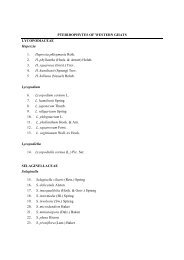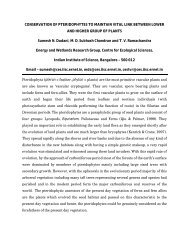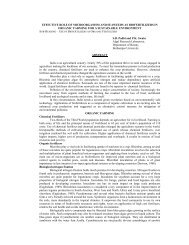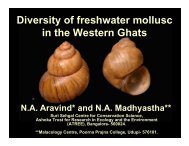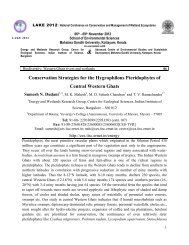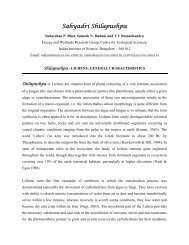regional wood energy development programme in asia ... - CES (IISc)
regional wood energy development programme in asia ... - CES (IISc)
regional wood energy development programme in asia ... - CES (IISc)
You also want an ePaper? Increase the reach of your titles
YUMPU automatically turns print PDFs into web optimized ePapers that Google loves.
Fuel<strong>wood</strong> is normally <strong>in</strong> the form of bondos (big round logs with a diameter of 8-12 <strong>in</strong>ches).<br />
The average fuel<strong>wood</strong> consumption per month is two truckloads at a cost of about 12,000 kyats.<br />
The fuel<strong>wood</strong> <strong>in</strong>put per viss of sugar produced, which sells for about 50 kyats, is only 0.8 kyats or<br />
1.6% of the ref<strong>in</strong>ed sugar output value. Even though the fuel<strong>wood</strong> share <strong>in</strong> the production cost is<br />
low, many manufacturers are look<strong>in</strong>g for local alternative sources of <strong>energy</strong>, eg. coconut shells etc.<br />
6.2.2 Evaporated Milk Plants<br />
There are, at present, 77 evaporated<br />
milk plants <strong>in</strong> Thazi, Meiktila, Pyawbwe,<br />
Mahla<strong>in</strong>g and Wundw<strong>in</strong>. The raw material,<br />
fresh milk, is readily available here with<strong>in</strong> the<br />
dry zone. The evaporated milk, besides for<br />
local consumption, f<strong>in</strong>ds its ma<strong>in</strong> markets <strong>in</strong><br />
Yangon and Taunggyi. The production of<br />
evaporated milk started because the imported<br />
variety became very expensive. The local<br />
product is well accepted and is popularly<br />
known <strong>in</strong> tea- shop jargon as "ord<strong>in</strong>ary" <strong>in</strong><br />
contrast to "shai" which means a cup with<br />
imported condensed milk.<br />
The production capacity of evaporated<br />
milk plants <strong>in</strong> the area varies from 80-200<br />
viss (130-325 kg.) of evaporated milk per day.<br />
The ma<strong>in</strong> source of <strong>energy</strong> used is bamboo<br />
fuel (about 70% of the total) with<br />
requirements rang<strong>in</strong>g from 300-1,500<br />
bundles of bamboo fuel per day per factory.<br />
To produce a viss of evaporated milk, which<br />
fetches a price of 90 kyats, about 3 viss of<br />
the ma<strong>in</strong> <strong>in</strong>gredient, fresh milk, at the cost of<br />
about 20 kyats/viss is required, besides<br />
sugar. The cost of bamboo fuel is about 6<br />
kyats per viss of the output or about 7% of<br />
the sell<strong>in</strong>g price.<br />
29<br />
Figure 6.7 Bamboo-fired furnace <strong>in</strong><br />
a milk evaporation plant<br />
Producers consider this <strong>wood</strong>fuel cost<br />
high and they are look<strong>in</strong>g for alternatives although they know that the quality of evaporated milk<br />
prepared with bamboo fuel is better. A variety of other possible sources of <strong>energy</strong> may <strong>in</strong>clude rice<br />
husks and local mesquite <strong>wood</strong> collected from live-fences, fallow and wastelands. The cost of<br />
these alternative sources is estimated to be about 2.40 kyats (rice husks) to 3 kyats (mesquite) per<br />
viss produced. Time will tell whether these alternative fuels will be widely accepted consider<strong>in</strong>g the<br />
quality standard of the product.




